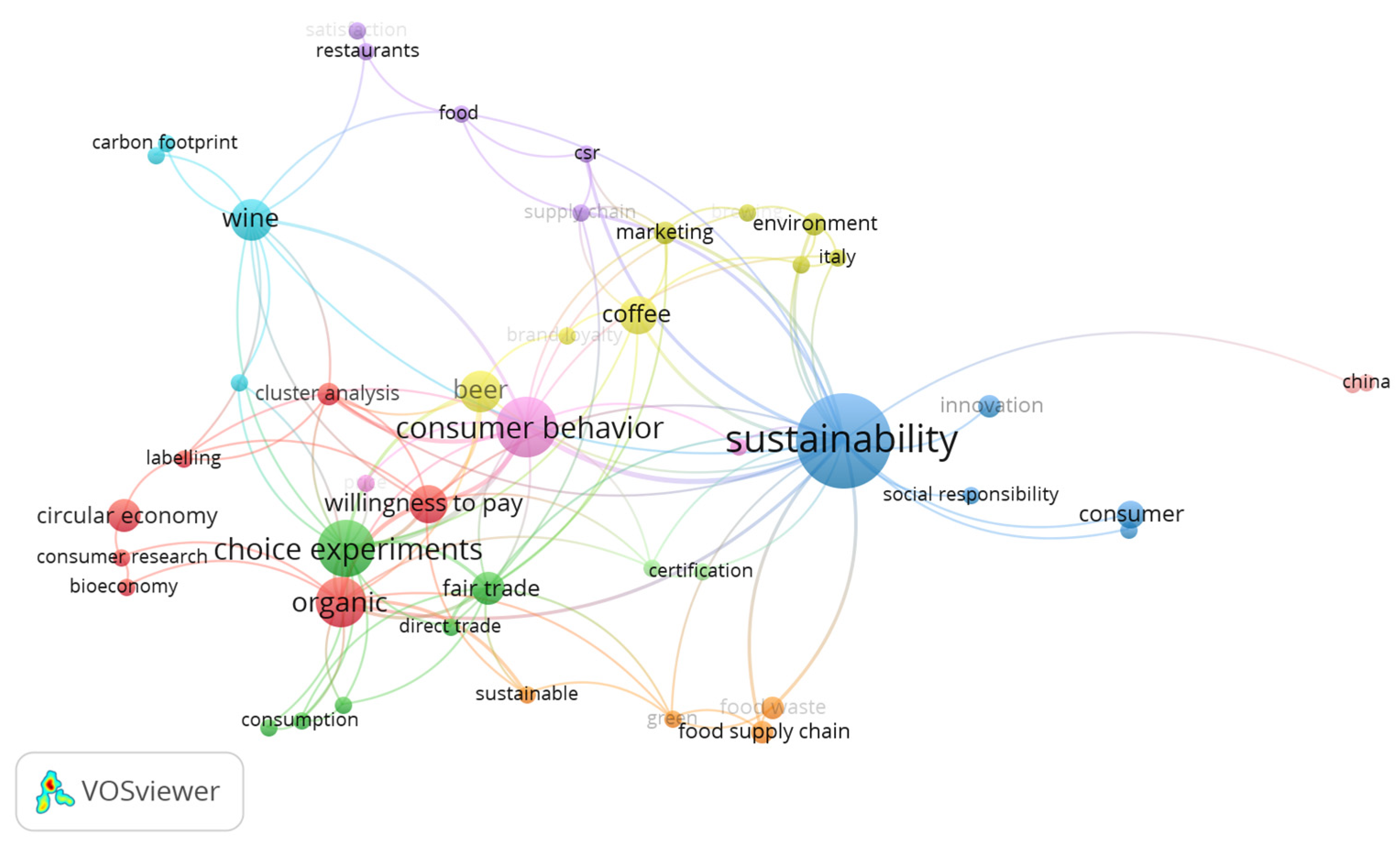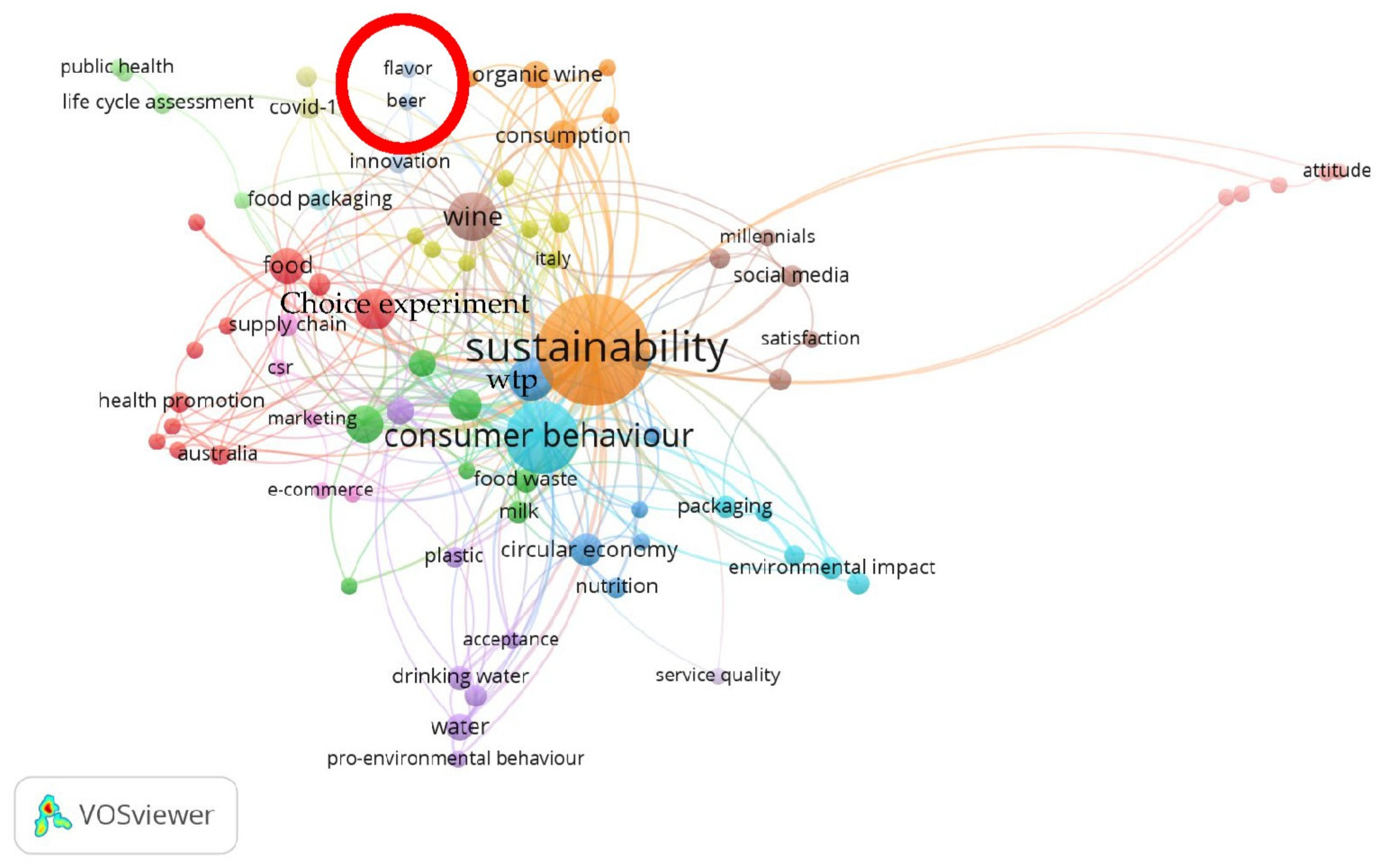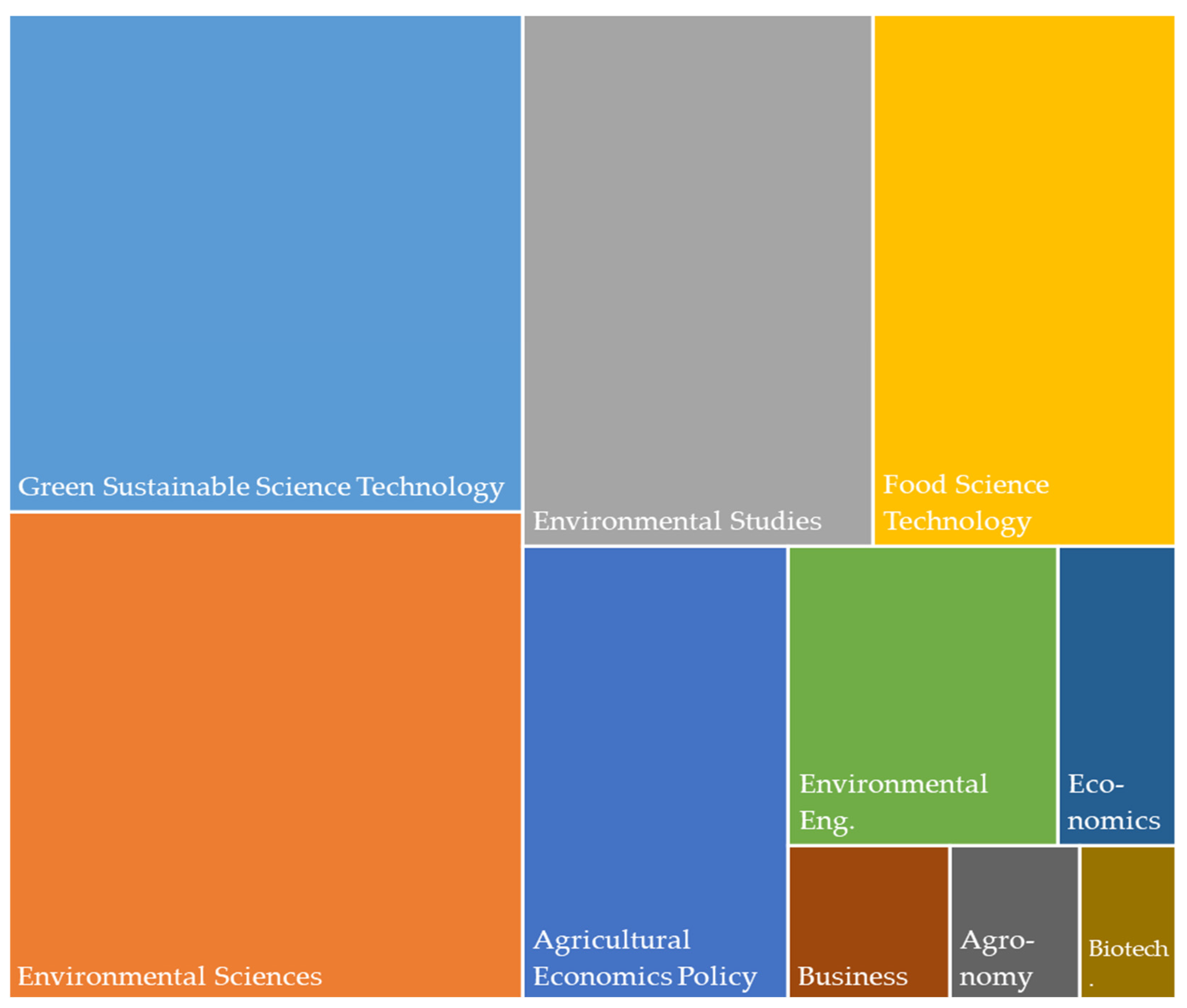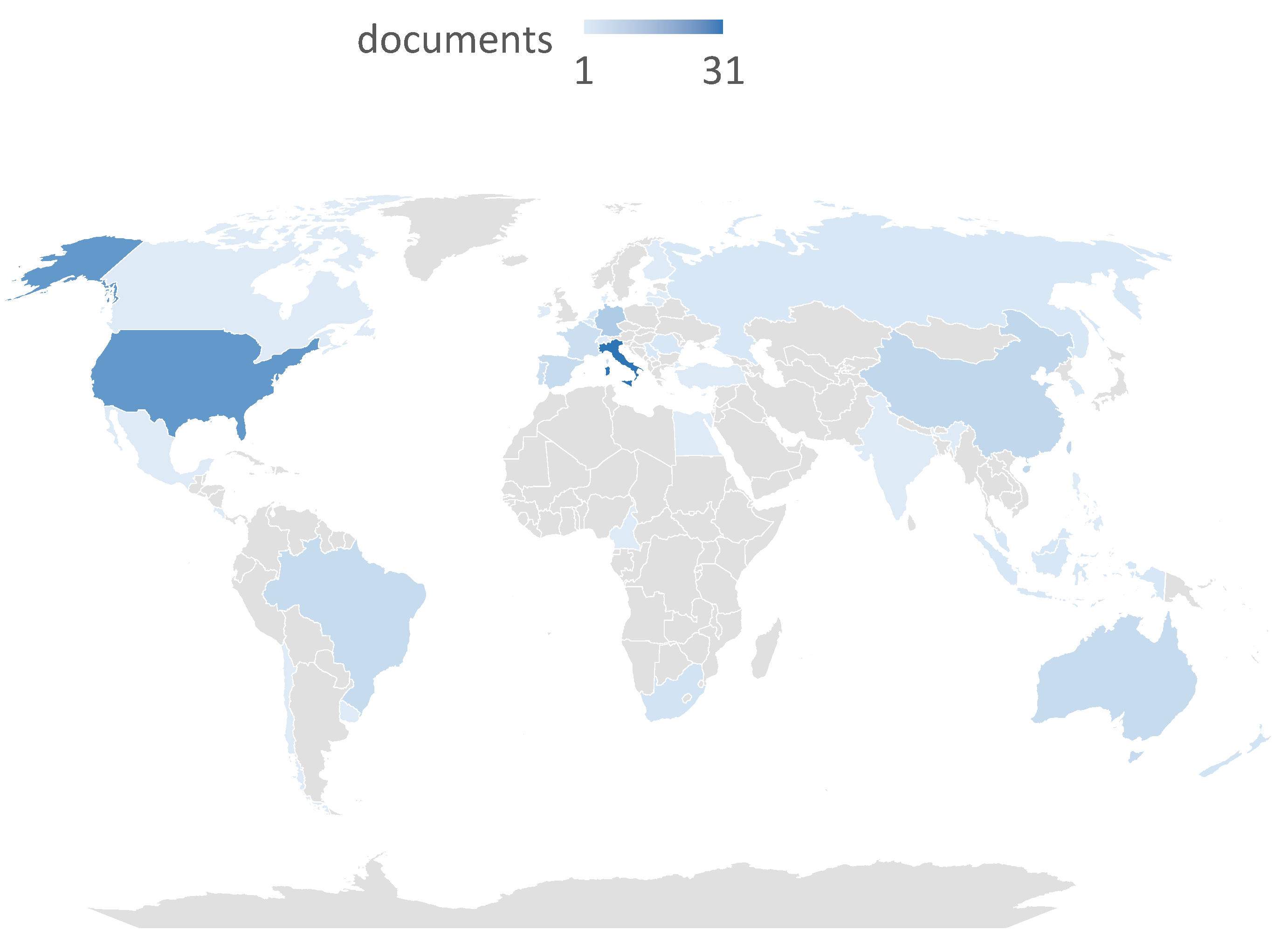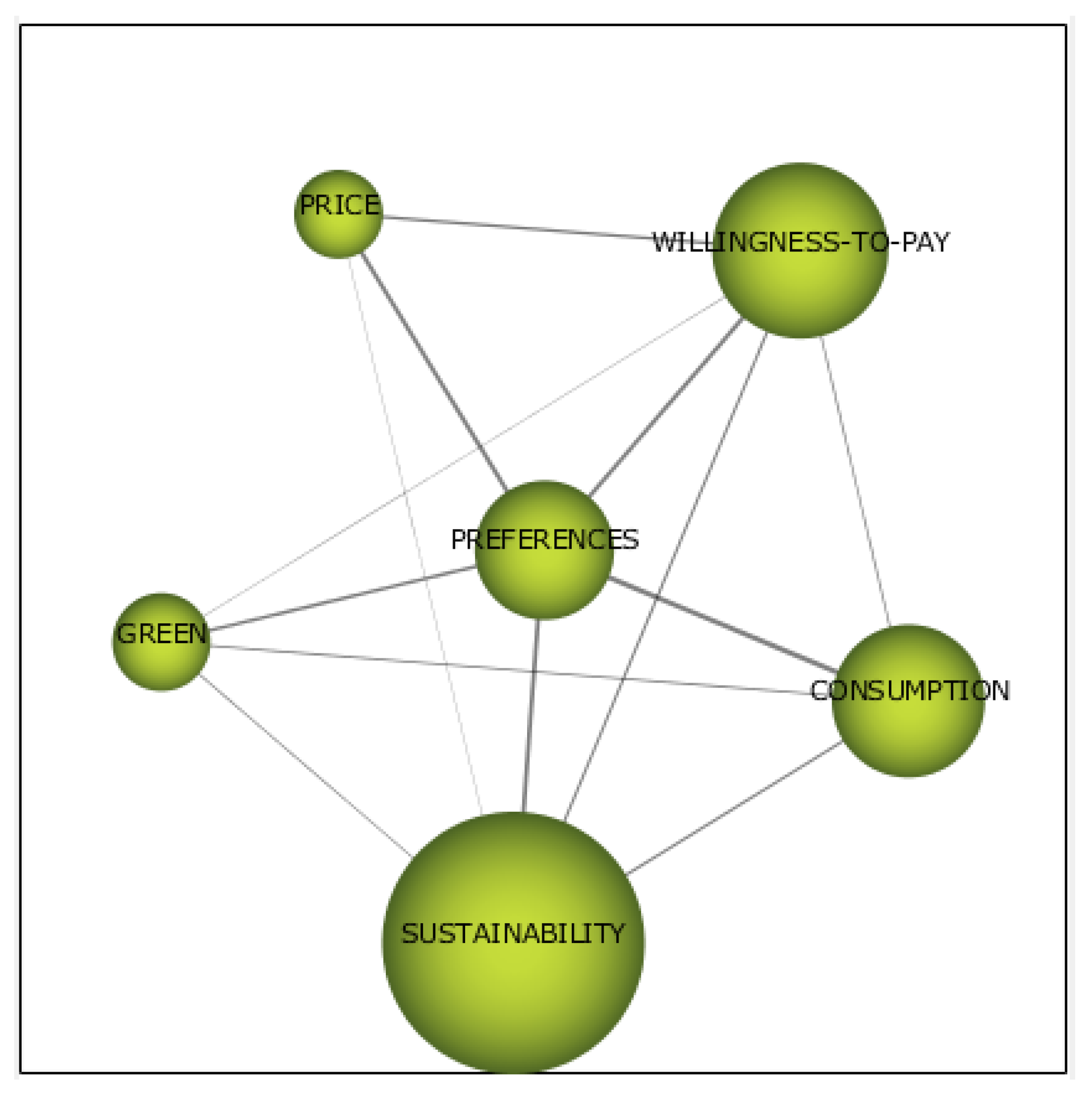3.1. Bibliometric Analysis Using VOSviewer
Firstly, as described in
Table 1, the process opens with a literature search that provides an overview of how the field has developed.
Figure 1 shows a co-occurrence graph of keywords.
This graph shows, through the size of each sphere, the number of times each keyword appears. The links between the circles represent the simultaneous occurrence of two keywords within the same article. Keywords that frequently appear together are grouped into clusters, each represented by a different colour. Topics with a higher number of connections are positioned closer to the centre, while those with fewer links are located further from the core.
The analysis of
Figure 1 reveals that, as expected, ”sustainability” is the most frequently occurring keyword across the studies. Furthermore, within the field of consumer preference research for sustainable products in the beverage sector, beer, wine, and coffee-related products are the most studied in the literature.
From a methodological perspective, again as expected, ”consumer behaviour” is the most commonly used keyword. Notably, the choice experiment technique and the estimation of WTP emerge as the most prominent theoretical approaches in this field.
The analysis of
Figure 1 already allows us to draw a first conclusion: in the field of consumer preferences for sustainable products, beer appears to be relatively under-researched. It is worth noting that the keyword “beer” was explicitly included in the search strategy; however, keywords such as “wine” and “coffee” appear almost as frequently as “beer” itself. This suggests that there are relatively few studies focused exclusively on the beer sector. As a result, most of the articles retrieved in the search are not centred solely on beer but rather address the broader category of beverages, and often fall within the wider scope of the food and drink industry.
To further contextualise this point, we conducted an additional literature search in which the term “beverag*” was used instead of “beer”, allowing for a clearer comparison between research developments on beer and other related fields.
Figure 2 shows a co-occurrence map similar to the previous one, but covering the broader domain of beverages. The area of the map where “beer” appears as a keyword is highlighted with a red circle.
Figure 2 shows that wine- and water-related products are the most extensively studied in the literature. Dairy and beer products also receive a certain degree of attention, although to a much lesser extent. Packaging and its sustainability also emerge as a noteworthy area of focus.
Therefore, it is clear that research on consumer interest in sustainable beer represents a gap within the broader field of beverage studies. This highlights the need to expand research in this area, with a recommendation to adopt choice experiment methodologies and WTP estimations, as has been performed in studies of other beverages.
Focusing once again on the 112 studies identified in the literature search, it is worth noting that these articles are published in 37 different academic journals (
Table 2). Of these,
Sustainability stands out with 34 articles (30.36%), followed by the
British Food Journal with 17 articles (15.18%), and the
Journal of Cleaner Production with 14 articles (12.50%). The full list is presented in
Table 2.
Thus, although more than half of the articles are published in just three journals, the diversity of published papers spanning different disciplines is considerable. This indicates that the topic addressed in this research is approached from multiple perspectives. This is further evidenced by the wide range of leading research areas, as shown in
Figure 3, where the main fields include ”Green and Sustainable Science and Technology” and ”Environmental Sciences”.
To analyse the current relevance of the topic under study,
Figure 4 shows the temporal evolution of the number of articles and citations. As can be observed, the number of publications has increased significantly over the past decade, as has their impact, as reflected in the number of citations. The number of documents reached two notable peaks in 2019, the year before the pandemic, and in 2022, while the number of citations has risen steadily throughout the period.
Numerous studies highlight the importance of clear and effective communication as an essential condition for promoting consumer acceptance of sustainable products. In this regard, refs. [
18,
19] conclude that communication efforts must be intensified in order to exert greater influence over purchasing decisions. The lack of specific and comprehensible information remains one of the principal barriers to encouraging responsible consumer behaviour.
In the specific context of sustainable wine, several studies similarly identify this deficiency. Ref. [
20] analyses the environmental impact of different types of packaging, focusing in particular on recycling, while excluding phases such as production and transportation. The authors conclude that there are significant discrepancies between consumer perceptions and scientific findings, largely attributable to poor communication regarding the environmental impacts of products. These discrepancies hinder consumers’ ability to make informed decisions.
Other studies examine consumer preferences concerning natural wines. Galati et al. [
10] show that the lack of clear and precise information on labelling and product characteristics constitutes a barrier to consumers incorporating environmental criteria into their purchasing decisions. In a similar vein, the authors of ref. [
21] identify in their analysis of consumer preferences for Californian Sauvignon Blanc a lack of accessible and detailed information regarding key sustainability aspects—specifically water management and organic production methods. This informational gap hinders consumers’ ability to recognise and appreciate the added value associated with sustainable practices, thereby reducing their influence on purchasing decisions.
Ref. [
22] explores the relationship between sustainability orientation and the adoption of innovative tools in the wine sector. This study indicates that organic certifications and the efficient use of water resources are factors that consumers consider important. Nevertheless, the failure to integrate these attributes into marketing strategies limits their potential to improve the competitive positioning of sustainable wineries in the market.
Ref. [
23], meanwhile, focuses on the segmentation of sustainable wine consumers based on their environmental beliefs and knowledge of sustainability certifications. The findings confirm that the absence of effective communication regarding the environmental benefits of such products hinders consumers’ willingness to pay and reduces the positive environmental impact that could result from their purchasing decisions.
In the same line, ref. [
24] examines the factors influencing consumers’ WTP for natural wines, including product characteristics, personal attitudes, and sociodemographic variables. For product characteristics, these include the use of local or organic ingredients [
7], sustainable packaging such as low-carbon cans [
3], and environmental certifications like “eco-friendly” labels [
5]. Sensory attributes such as taste and perceived quality also reinforce product authenticity [
8].
For personal attitudes, environmental commitment and ethical values play a key role in purchase decisions [
25]. Consumers who favour artisanal and local products show greater willingness to pay for sustainable options [
13]. Price sensitivity is moderated by perceived added value [
14].
For sociodemographic variables, age (with greater sensitivity among younger generations such as millennials and Gen Z) [
10], education level [
6], and income [
26] are positively correlated with willingness to pay for sustainable products. Geographic location also plays a role, with urban consumers showing greater proactivity and access to such products [
9]. The study concludes that the lack of communication regarding health and environmental aspects again prevents consumers from adequately valuing the attributes of natural wine. It also notes that product quality is not always associated with the presence of certifications, thereby reinforcing the need to enhance the information provided to end consumers.
Ref. [
27] investigates the effect of sustainability messages on consumer behaviour, concluding that a greater amount of information on sustainability is positively associated with a higher WTP. The study highlights the importance of clear and comprehensive communication in promoting sustainable products, as it demonstrates that consumer knowledge directly influences their willingness to support environmentally responsible initiatives through their purchasing decisions.
Similarly, ref. [
28] analyses consumer preferences for wine in relation to innovation and sustainability. The results show that consumers place greater value on traditional attributes such as grape variety, certifications, or protected geographical indications, over more innovative characteristics like alcohol-free or vegan wines. This prioritisation suggests that although there is growing interest in sustainability, traditional factors continue to play a decisive role in consumer choice.
Likewise, although in a different sector, Kolk’s study on coffee producers [
11] raises similar challenges. Despite the coffee analysed being certified by Utz, the absence of Fairtrade certification limits its competitiveness. This case illustrates the need to align corporate sustainability strategies with regulatory requirements and evolving market expectations, where recognised labels still play a decisive role in shaping consumer perception.
Various studies focused on the wine sector have examined the influence of social factors on consumers’ willingness to pay more for sustainable products. Galati et al. [
10] investigate which consumer profiles are more inclined to pay for natural wines and find that millennials show a higher WTP when provided with clear information through labelling. This finding reinforces the idea that informational transparency in labelling may play a key role in fostering sustainable consumption among younger segments.
In a complementary approach, ref. [
25] examines factors influencing brand loyalty in local beer products, observing a strong emotional connection between consumers and unique products, particularly among local residents and tourists. The perception of authenticity and the sense of community emerge as key elements in generating loyalty, suggesting the importance of incorporating social and cultural values into the positioning strategies of sustainable products.
The impact of social media marketing is the focus of the study by the authors of [
29]. Their findings indicate that companies can significantly enhance marketing strategies through more transparent communication of sustainable practices. This line of research not only increases credibility among consumers but may also strengthen the positioning of sustainability-committed brands in an increasingly environmentally demanding market.
Lastly, ref. [
30] examines the impact of the COVID-19 pandemic on sustainability in the supply chains of organic restaurants and local businesses in the United States. The results suggest that despite the crisis, the perception of sustainability had a positive effect on both tourists and the destination’s brand image. However, the authors note that it is necessary to reinforce local communication on sustainability to consolidate this perception and encourage deeper consumer engagement.
The following section analyses the citation metrics for each article.
Figure 5 shows a graphical analysis of citations. In the map generated by VOSviewer, the nodes represent documents, while the size of each node reflects its number of citations within the set. The connections between nodes indicate direct citation relationships, and the colours group the documents into thematic clusters that are closely related through common citation patterns. The most cited articles are shown in
Table 3.
The review on wine in [
19] stands out as the most central and cited node, acting as a conceptual pivot between different research areas. Its position on the map and its connections with multiple clusters suggest that it serves as a transversal reference work. In contrast, the study by the authors of [
20], although belonging to the same thematic cluster (yellow), appears more isolated, as it represents a more specialised contribution focused on packaging.
The red cluster, comprising documents such as those in refs. [
10,
21,
23,
28], focuses on the acceptance of sustainable wine and the factors influencing consumers’ willingness to pay. The proximity of these studies is due to the strong thematic coherence within this well-established research line.
Finally, the blue cluster, led by [
25], is the most relevant to our focus, as it specifically analyses beer. The link to the central node is established through works such as the WTP analyses in [
5,
13], as well as the literature review on craft beer in [
8]. Also included are the study by the authors of [
26] on WTP among Italian consumers and the recent work in [
31] on beer consumer preferences in Italy. The findings of the studies in this cluster are summarised in
Table 4.
Figure 5.
Citation network map of articles retrieved from Web of Science. Articles represented in the network include: Staples (2020) [
5], Nave (2022) [
8], Galati (2019) [
10], Schaeufele (2017) [
19], Boesen (2019) [
20], Tait (2019) [
21], Sogari (2016) [
23], Murray (2015) [
25], Pilone (2023) [
26], Stanco (2020) [
28], Mesidis (2023) [
32], Chauvin (2023) [
33], and Rabadan (2021) [
34].
Figure 5.
Citation network map of articles retrieved from Web of Science. Articles represented in the network include: Staples (2020) [
5], Nave (2022) [
8], Galati (2019) [
10], Schaeufele (2017) [
19], Boesen (2019) [
20], Tait (2019) [
21], Sogari (2016) [
23], Murray (2015) [
25], Pilone (2023) [
26], Stanco (2020) [
28], Mesidis (2023) [
32], Chauvin (2023) [
33], and Rabadan (2021) [
34].
Table 3.
Most cited articles, according to the Web of Science.
Table 3.
Most cited articles, according to the Web of Science.
| Authors | Title | Citations |
|---|
| Schäufele & Hamm [19] | Consumers’ perceptions, preferences and willingness-to-pay for wine with sustainability characteristics: A review | 295 |
| Boesen, et al. [20] | Environmental sustainability of liquid food packaging: Is there a gap between Danish consumers’ perception and learnings from life cycle assessment? | 161 |
| Galati et al. [10] | “Natural wine” consumers and interest in label information: An analysis of willingness to pay in a new Italian wine market segment | 139 |
| Murray & Kline [25] | Rural tourism and the craft beer experience: factors influencing brand loyalty in rural North Carolina, USA | 120 |
| Tait et al. [21] | Estimating wine consumer preferences for sustainability attributes: A discrete choice experiment of Californian Sauvignon Blanc purchasers | 87 |
| Fiore et al. [22] | Understanding the relationship between green approach and marketing innovations tools in the wine sector | 76 |
Table 4.
Summary of articles on sustainable beer consumption.
Table 4.
Summary of articles on sustainable beer consumption.
| Authors | Summary | Methods | Core Objective |
|---|
| Cascone et al. [31] | Italian consumer preferences for craft beer | Conjoint analysis on attributes and preferences of Italian consumers | WTP |
| Cela et al. [7] | Perceptions of local fruit use and by-products | Survey on sustainability, taste, and materials used | Purchase intention |
| Lourenço & Piotto [9] | Environmental attributes and consumer behaviour | Survey with structural modelling on sustainable attitudes | Purchase intention |
| Norris et al. [3] | Sustainable secondary packaging and consumer perception | Experiment on packaging innovation and sustainability | Indirect effects on purchase |
| Pilone et al. [26] | Determinants of consumption of craft beer and WTP in Italy | Survey and machine learning to estimate consumer profiles | WTP |
| Nave et al. [8] | Systematic literature review on craft beer | Bibliometric analysis of academic articles | Bibliographic revision |
| Lee et al. [35] | Water conservation practices in brewing and their effect on purchase intention | Online experiment on macro and craft beer practices | Purchase intention |
| Staples et al. [5] | WTP for specific sustainable practices on brewing | Choice experiment with concrete environmental attributes | WTP |
| Carley & Yahng [13] | Factors predicting WTP for sustainable beer | Survey with analysis of individual predictors | WTP |
| Poelmans & Rousseau [2] | Preferences for organic beer | Choice experiment in Belgium on eco-labels | WTP |
| Murray & Kline [25] | Brand loyalty in rural beer tourism | Survey on branding and community connection | Branding |
The country distribution of the published studies is shown in
Figure 6. It highlights the high volume of articles of institutions from countries with strong scientific output, such as the United States and China, but also from others where overall scientific production is comparatively lower, such as South Africa, Australia, and especially Italy, which accounts for 31 documents. This pattern reflects the correlation with the significance of the beer industry and, in particular, the wine industry in Italy.
3.2. Thematic Analysis with SciMAT
Bibliometric techniques contribute to assessing both scientific activity and the impact of research [
36,
37]. Numerous studies have applied such methods in the context of systematic literature reviews across various scientific domains [
36,
38,
39,
40,
41,
42,
43,
44,
45].
To analyse the studies on sustainable beer production and consumption, a thematic analysis was conducted using the SciMAT software [
17]. This analysis reinforces the relevance of the topic under investigation. Scientific mapping aims to illustrate both the structural and dynamic aspects of scientific research, as well as to represent the cognitive structure of a research field. Following ref. [
46], several techniques have been developed to construct bibliometric maps, the most commonly employed being document co-citation analysis and co-word analysis.
As in other bibliometric studies by various authors [
37,
47,
48], the SciMAT software was used in conjunction with data retrieved from the Web of Science database to analyse the research dynamics surrounding the key themes and trends in sustainable beer production, as well as the broader relationship between sustainability and consumer behaviour across a range of products [
49,
50,
51,
52]. As this analysis is based on the same Web of Science search used for the VOSviewer analysis, no further explanation of the searching method is provided here.
By applying co-word analysis to construct the scientific map, clusters of keywords and their interconnections are progressively identified—these clusters are hereafter referred to as themes. Each research theme generated through this process is characterised by two parameters: density and centrality [
53,
54]. Based on these parameters, four types of themes may be distinguished: motor, emerging, specialised, and transversal.
According to the strategic diagram generated by SciMAT—results of which are shown in
Figure 7 and detailed in
Table 5—the motor themes in research concerning consumer preferences for sustainably produced beer are “preferences” and “food”. These are the most prominent themes in the field, appearing in the highest number of publications. “Preferences” is both highly central and dense, whereas “food“ shows greater density than centrality. These two themes are well-developed and integral to the structure of this research field, being strongly interconnected with each other and with other themes.
Additionally, the theme “quality“ may be considered an emerging area, showing greater centrality than density. “Behaviour” appears as a basic or transversal theme, with internal potential for further development. Finally, “perceptions” emerges as a highly developed theme that may currently be in decline or less actively explored.
These clusters, in turn, are composed of various subthemes or nodes. The composition of the “preferences” cluster is detailed in
Table 6 and
Figure 8, where it can be observed that the “sustainability” node contains the highest number of publications, followed by “willingness to pay” and “consumption”. Their strong interconnections suggest that the theme of consumer preferences serves as a conceptual bridge between “sustainability”, “consumption”, and “willingness to pay”. “Price” analysis emerges as a less-explored topic, although it is relatively well-connected within the thematic network.
The composition of the “food” cluster is shown in
Table 7, with its structure illustrated in
Figure 9. The dominant node within this cluster is “attitudes”, with “information” also playing a relevant role. However, this theme appears to be less dense and central than “preferences”. The interconnections are not particularly strong, although the presence of the term “wine”—as previously discussed—confirms its status as a well-studied topic in this field.

